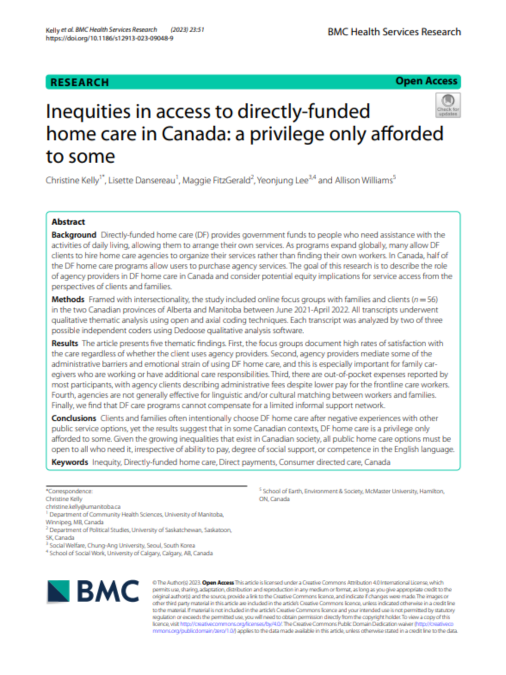Inequities in access to directly-funded home care in Canada: a privilege only afforded to some
Directly funded home care in Canada, like other countries, is a key element of the public commitment to prioritize home care services that meet the needs of diverse older people and people with disabilities. Yet, as these programs expand in size and popularity, it is essential to reflect on the barriers that can be created through decisions in policy design.
Author: Christine Kelly, Lisette Dansereau, Maggie FitzGerald, Yeonjung Lee & Allison Williams
Publication Date: January 18, 2023
Description:
Background
Directly-funded home care (DF) provides government funds to people who need assistance with the activities of daily living, allowing them to arrange their own services. As programs expand globally, many allow DF clients to hire home care agencies to organize their services rather than finding their own workers. In Canada, half of the DF home care programs allow users to purchase agency services. The goal of this research is to describe the role of agency providers in DF home care in Canada and consider potential equity implications for service access from the perspectives of clients and families.
Methods
Framed with intersectionality, the study included online focus groups with families and clients (n = 56) in the two Canadian provinces of Alberta and Manitoba between June 2021-April 2022. All transcripts underwent qualitative thematic analysis using open and axial coding techniques. Each transcript was analyzed by two of three possible independent coders using Dedoose qualitative analysis software.
Results
The article presents five thematic findings. First, the focus groups document high rates of satisfaction with the care regardless of whether the client uses agency providers. Second, agency providers mediate some of the administrative barriers and emotional strain of using DF home care, and this is especially important for family caregivers who are working or have additional care responsibilities. Third, there are out-of-pocket expenses reported by most participants, with agency clients describing administrative fees despite lower pay for the frontline care workers. Fourth, agencies are not generally effective for linguistic and/or cultural matching between workers and families. Finally, we find that DF care programs cannot compensate for a limited informal support network.
Conclusions
Clients and families often intentionally choose DF home care after negative experiences with other public service options, yet the results suggest that in some Canadian contexts, DF home care is a privilege only afforded to some. Given the growing inequalities that exist in Canadian society, all public home care options must be open to all who need it, irrespective of ability to pay, degree of social support, or competence in the English language.
Access: Free
Keywords: Inequity, Directly-funded home care, Direct payments, Consumer directed care, Canada



